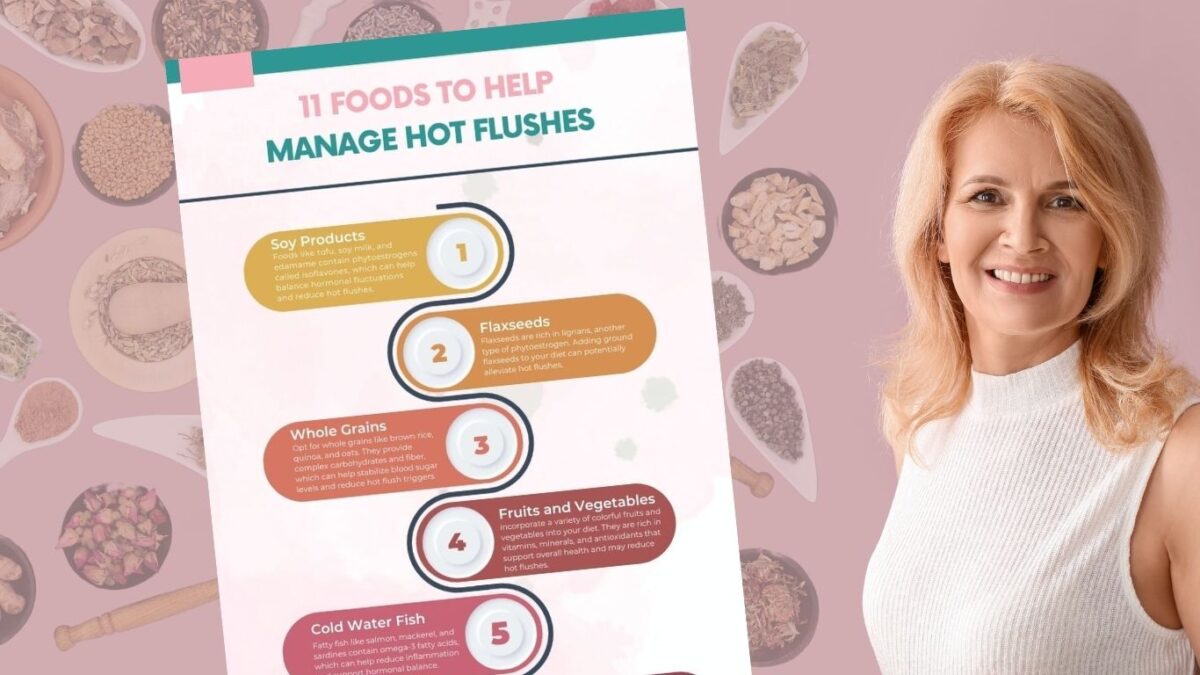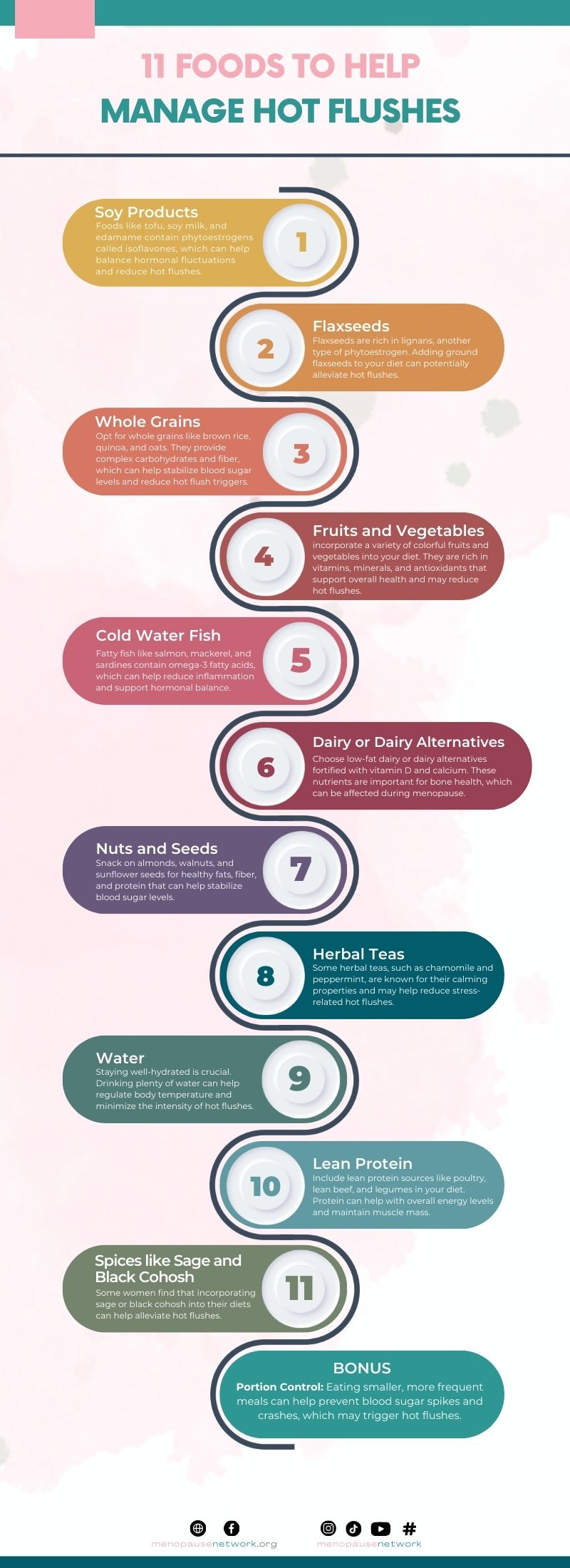Proven & Tested Dietary Guide to Taming Hot Flushes

As women gracefully transition into the menopausal phase of life, they often encounter a range of hormonal changes and accompanying symptoms. Among these, hot flushes can be particularly bothersome, disrupting daily routines and leaving one searching for relief. But what if the key to alleviating hot flushes lies on your plate?
In this blog post, we will explore the power of nutrition as a natural and effective tool for managing hot flushes during menopause. From soy-rich foods to soothing herbal teas, we’ll delve into a range of dietary tips and food choices that can help you navigate this phase of life with more comfort and control.
So, if you’re looking to stay cool and collected while experiencing the warmth of menopause, read on for a comprehensive guide to the foods and dietary strategies that can make a significant difference in your journey. Let’s nourish our bodies and embrace this transformative time with grace and vitality.
- Soy Products: Soy products contain phytoestrogens called isoflavones, which have estrogen-like properties. These compounds can help mitigate the hormonal imbalances that trigger hot flushes. Consider adding the following soy-based foods to your diet:
- Tofu: Tofu is a versatile ingredient that can be used in various dishes, from stir-fries to smoothies. It’s an excellent source of plant-based protein and isoflavones.
- Soy Milk: Swap regular cow’s milk with soy milk in your cereal or coffee. Make sure to choose unsweetened varieties for a healthier option.
- Edamame: These young soybean pods are a tasty and nutritious snack. Steam them and lightly salt them for a satisfying treat.
- Flaxseeds: Flaxseeds are rich in lignans, which are natural compounds that have weak estrogenic effects. Incorporating ground flaxseeds into your diet can be an effective way to reduce hot flushes. You can:
- Sprinkle on Cereal or Yogurt: Add a tablespoon of ground flaxseeds to your breakfast for extra fiber and lignans.
- Use as an Egg Substitute: Mix ground flaxseeds with water to create a gel-like substance that can replace eggs in recipes.
- Whole Grains: Whole grains are an essential part of a balanced diet, and they can help regulate blood sugar levels, preventing hot flush triggers. Opt for:
- Brown Rice: Swap white rice for brown rice in your meals. It’s higher in fiber and nutrients.
- Quinoa: Quinoa is a protein-packed grain that’s also rich in fiber. It makes a great base for salads or a side dish.
- Oats: Enjoy oatmeal for breakfast with some fruit and a drizzle of honey. Oats are not only heart-healthy but can also help stabilize blood sugar.
- Fruits and Vegetables: Colorful fruits and vegetables provide an array of vitamins, minerals, and antioxidants that support overall health and may reduce hot flushes. Focus on:
- Berries: Blueberries, strawberries, and raspberries are rich in antioxidants and can be added to yogurt or eaten as a snack.
- Leafy Greens: Spinach, kale, and Swiss chard are packed with nutrients. Incorporate them into salads, smoothies, or as side dishes.
- Citrus Fruits: Oranges, grapefruits, and lemons are high in vitamin C and can boost your immune system.
- Cruciferous Vegetables: Broccoli, cauliflower, and Brussels sprouts contain compounds that may help balance hormones.
- Cold Water Fish: Fatty fish like salmon, mackerel, and sardines are excellent sources of omega-3 fatty acids. These healthy fats have anti-inflammatory properties and can support hormonal balance. Aim to include fish in your diet at least twice a week.
- Dairy or Dairy Alternatives: Dairy products, such as milk and yogurt, provide essential nutrients like calcium and vitamin D, which are crucial for bone health. If you’re lactose intolerant or prefer dairy alternatives, opt for fortified options like almond milk or soy yogurt.
- Nuts and Seeds: Snacking on almonds, walnuts, and sunflower seeds provides healthy fats, fiber, and protein, which can help stabilize blood sugar levels and keep you feeling full and satisfied between meals.
- Herbal Teas: Herbal teas can provide comfort and relief from hot flushes while offering a calming effect. Consider incorporating these herbal teas into your daily routine:
- Chamomile Tea: Known for its soothing properties, chamomile tea can help reduce stress and promote relaxation.
- Peppermint Tea: Peppermint tea is refreshing and can provide a cooling sensation, which may help alleviate hot flushes.
- Sage Tea: Some women find relief from hot flushes by drinking sage tea. Sage contains compounds that may help regulate hormonal fluctuations.
- Water: Staying well-hydrated is crucial for overall health and can help regulate body temperature. Dehydration can exacerbate hot flushes, so make a conscious effort to drink enough water throughout the day. Carry a reusable water bottle with you to ensure you’re getting an adequate intake.
- Lean Protein: Including lean sources of protein in your diet, such as poultry, lean beef, and legumes, can help maintain muscle mass and provide a steady source of energy. This can be particularly important during menopause when metabolic changes may occur.
- Spices like Sage and Black Cohosh: Some women have reported relief from hot flushes by incorporating specific herbs and spices into their diets. Sage and black cohosh, in particular, are known for their potential benefits in managing menopausal symptoms. However, it’s essential to consult with a healthcare provider before using herbal remedies to ensure they are safe and appropriate for your individual needs.
- Portion Control: Eating smaller, more frequent meals can help prevent blood sugar spikes and crashes, which can trigger hot flushes. By spacing out your meals and snacks throughout the day, you can maintain steady energy levels and avoid sudden temperature fluctuations.
Here’s an infographic you can utilize and share, condensing the dietary guidelines for effectively managing hot flushes.

Incorporating these dietary tips into your daily life can contribute to better management of hot flushes and improve your overall well-being during menopause. Remember that individual responses to foods and herbal remedies can vary, so it’s a good idea to keep a journal to track how specific items affect your symptoms. Additionally, consult with a healthcare provider or registered dietitian for personalized advice and guidance tailored to your unique needs and health conditions.
On the flip side, here are the 10 things you should steer clear of since they can trigger hot flushes.
